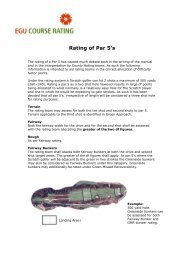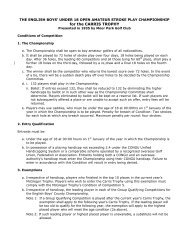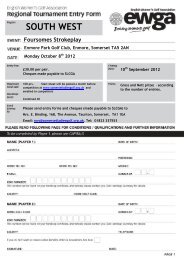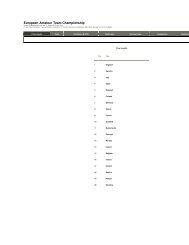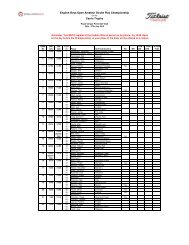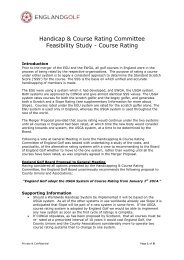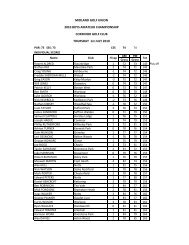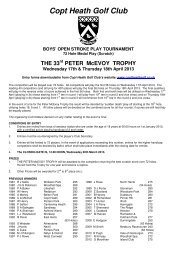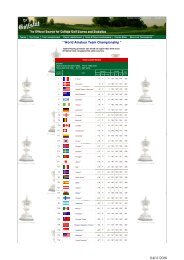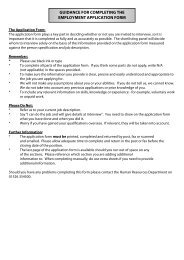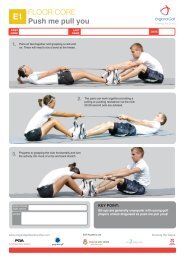Welcome Booklet - England Golf
Welcome Booklet - England Golf
Welcome Booklet - England Golf
You also want an ePaper? Increase the reach of your titles
YUMPU automatically turns print PDFs into web optimized ePapers that Google loves.
EGU/EWGA <strong>Golf</strong> Development Team<br />
The National <strong>Golf</strong> Centre,<br />
Woodhall Spa,<br />
Lincs LN10 6PU<br />
Tel: 01526 354500<br />
Email: development@englishgolfunion.org<br />
www.golfclubtoolkit.org<br />
<strong>Welcome</strong><br />
<strong>Booklet</strong><br />
for new golf club<br />
members & players<br />
This booklet aims to support new golfers<br />
coming into golf club membership to<br />
get the most out of being a member.
1/ <strong>Golf</strong> Club Details<br />
Role of the EGU and EWGA<br />
The English <strong>Golf</strong> Union (EGU) and English Women's<br />
<strong>Golf</strong> Association (EWGA) are the governing bodies<br />
for men's and women's amateur golf respectively.<br />
In 2005, the EGU, EWGA and Professional <strong>Golf</strong>ers'<br />
Association (PGA), with the support of the <strong>Golf</strong><br />
Foundation and Sport <strong>England</strong> formed the<br />
<strong>England</strong> <strong>Golf</strong> Partnership (EGP) to help ‘Grow the<br />
Game’.<br />
The EGU and EWGA have developed a variety of<br />
initiatives and resources to help develop the<br />
game of golf in <strong>England</strong>.<br />
What is the <strong>Welcome</strong> <strong>Booklet</strong>?<br />
The <strong>Welcome</strong> <strong>Booklet</strong> is a generic document which<br />
aims to educate new members and players on the<br />
fundamentals of golf and the golf club environment.<br />
This information will help new golfers to get the<br />
most out of the game and enjoy the experience<br />
of being a golf club member.<br />
Your <strong>Golf</strong> Club:<br />
Secretary/Manager:<br />
Tel No:<br />
Email:<br />
Web address:<br />
Name of Professional:<br />
Tel No:<br />
Email:<br />
Who’s Who<br />
● Secretary/Manager<br />
Normally a paid member of staff who is<br />
responsible for the day to day running of the golf<br />
club. If you have any general queries then this<br />
person is always a good starting point.<br />
● PGA Professional/s<br />
Usually runs the golf shop and delivers coaching.<br />
They may also represent the club in competitions<br />
and offer golfing advice to members on rules and<br />
competitions etc.<br />
● Committee / Management Board<br />
Dependant upon club structure, there may be a<br />
committee or board, with sub committees to<br />
look after different areas of club life, such as<br />
membership, competitions and forward planning.<br />
● Greens Staff<br />
Responsible for the upkeep of the course, they<br />
normally work during the early part of the day to<br />
avoid the busy playing times.<br />
● Ranger / Marshall<br />
Some clubs have a ranger or marshall to go out<br />
onto the course and help golfers if they have<br />
questions and/or need assistance. They also<br />
monitor speed of play and conduct.<br />
● Junior Organiser/s<br />
Coordinator for the junior section who arranges<br />
coaching and competitive activities for juniors<br />
(members and non-members).<br />
page 2 page 3
2/ Benefits of Being a <strong>Golf</strong> Club Member<br />
<strong>Golf</strong> Club Membership Benefits<br />
Obtaining an official golf club handicap (CONGU) - see page 16/17.<br />
Allows play in Open competitions, club competitions, regional leagues and alliances.<br />
When playing other courses, you may be required to show proof of an official handicap.<br />
Access to a range of competitions and social golf on a regular basis.<br />
Good for your health.<br />
Access to coaching with a qualified PGA Professional.<br />
Access to other golf courses through matches, competitions and reciprocals.<br />
Sense of belonging to a club and opportunity to make new friends.<br />
An activity the whole family can participate in.<br />
Clubs should have Public Liability insurance, but individuals should provide their own.<br />
<strong>Golf</strong> Club Facilities<br />
<strong>Golf</strong> clubs offer differing levels of facilities—details can be found at<br />
EGU <strong>Golf</strong> Central see www.englishgolfunion.org/golfcentral<br />
A golf course - usually 18 holes, but might<br />
be 9, 27 or 36 holes.<br />
Clubhouse - normally with changing rooms,<br />
golf shop, office, bar and/or restaurant.<br />
Putting/chipping green - for use to warm up<br />
and practice on.<br />
Driving range/practice ground - practice<br />
area for golfers. Discounts on golf balls may<br />
be available for members.<br />
Practice nets - available at some clubs to<br />
practice at prior to teeing off.<br />
Lockers - found in the changing rooms.<br />
The Secretary/Manager should be able to<br />
explain how to obtain one.<br />
Trolley/buggy shed—some clubs may<br />
provide space for members to leave their<br />
trolleys. Trolleys and buggies may also be<br />
available to hire.<br />
Professional shop—usually provides<br />
golfing equipment, clothing plus drinks<br />
and snacks.<br />
page 4 page 5
3/ General Club Information<br />
● Notice boards<br />
These are a good source of information for members and are normally split up into<br />
different categories. Some notices are there for information but others require your<br />
input, such as signing up for matches, entering competitions and updates for<br />
handicaps following competitions.<br />
● Club Diary / Handbook<br />
Some golf clubs issue members with a club handbook or diary, this usually has the<br />
competitions, matches and events for the forthcoming year. Other information<br />
normally contained are club contact details, rules of the club, opening hours,<br />
dress codes, green fee breakdown(s), who's who and other useful information about<br />
how the club operates.<br />
● Membership sections<br />
There are usually different membership sections within the golf club such as Mens,<br />
Ladies and Juniors. Further information on each section can be found on the relevant<br />
notice boards or through the Club Secretary/Manager.<br />
● Dress Codes & General Club Rules<br />
An important part of golf club membership is that members are<br />
aware of club rules and abide by them, they are there to make<br />
the game more enjoyable and to help with the smooth running of<br />
the club so that everyone understands the do’s and the don’ts.<br />
● Tee Times & Reservations<br />
How members reserve tee times varies. Tee reservations are usually<br />
for competitions and visiting parties and members can usually play<br />
when they want outside of these times. Members need to be aware<br />
that visiting parties are an important income for the golf club and<br />
need to be made welcome as it may subsidise the yearly membership<br />
subscriptions. Some clubs may operate a booking system where you<br />
book your tee time in advance.<br />
page 6 page 7
4/ The <strong>Golf</strong> Course & Outdoor Facilities<br />
All golf courses vary in terms of layout, what they look like and the length of the course. It is important<br />
that you orientate yourself with the layout of the course and you should be able to obtain a course<br />
plan guide to help you.<br />
Courses are often referred to as Links, Parkland, Heathland or Woodland courses.<br />
Links On the coast, normally few trees but lots of bunkers,<br />
sand dunes, well draining and firmer under foot.<br />
Wind is normally a main factor when playing.<br />
Parkland Inland and often set in amongst mature trees.<br />
They may have ponds and other water hazards and<br />
the holes often meander through the trees.<br />
Heathland On sandier land inland, normal features are gorse<br />
bushes, bunkers, heather and fewer trees.<br />
Woodland The holes tend to be lined with many trees and the<br />
other holes are therefore hidden from view.<br />
● Tees<br />
Tees are the starting point of a golf hole, normally a flat piece of land, which is mown neatly and<br />
may be called the Tee Box. The teeing area is identified by two markers, these vary and are<br />
coloured to show which tees should be used by who:<br />
White<br />
Medal competitions for men,<br />
some clubs also allow them<br />
to be used during the summer<br />
months for casual golf.<br />
Yellow<br />
Everyday use for the men,<br />
some clubs use for<br />
competitions.<br />
The colour of tees is not compulsory and therefore may vary at your club.<br />
Red<br />
Normally for ladies’<br />
everyday use and<br />
competitions.<br />
● Tee Furniture<br />
Refers to signs on the tee, which show the hole number, the length of the hole in yards<br />
(sometimes metres) and the stroke index of the hole (the stroke index determines where<br />
a golfer with a handicap gets their shots on the course - see Handicapping section).<br />
page 8 page 9
4/ The <strong>Golf</strong> Course & Outdoor Facilities<br />
● Fairways<br />
Closely mown grass areas that go from in front of the teeing area and up to the green. Semi rough and<br />
then deeper rough normally surround the fairway. The rough is grass cut longer than the fairway and is<br />
intended to penalise players that miss the fairway.<br />
● The Green<br />
The area that you are trying to get the ball onto, as this is where the hole is situated. They are well<br />
maintained areas of grass that are mown very low so that they are a smooth surface for putting on.<br />
They vary in size and shape and have differing levels of slope. The hole location on a green is moved<br />
by the greens staff on a regular basis.<br />
● Hazards<br />
Occur as golf courses are made up of many different features, trees, length of grass, bunkers,<br />
water and bushes. If you hit your ball straight, it is rare to encounter hazards but if you go off line<br />
BUNKERS<br />
A hazard consisting of a prepared area of ground,<br />
often a hollow, from which turf or soil has been<br />
removed and replaced with sand or the like.<br />
WATER HAZARDS<br />
Any sea, lake, pond, river, ditch, surface drainage,<br />
ditch or other open water course (whether or not containing<br />
water) and anything of a similar nature<br />
on the course.<br />
LATERAL WATER HAZARD<br />
A water hazard or part of a water hazard so situated<br />
that it is not possible, or is deemed by the committee<br />
to be impracticable, to drop a ball behind the water<br />
hazard in accordance with the rules.<br />
ROUGH<br />
Grass grown longer than that on the fairway.<br />
they come into play. They break up the landscape but also make golfers manage their way around<br />
the course. Some brief descriptions of hazards you may encounter are shown on the opposite page: Local Rules<br />
Local rules are specific to your club and it is important that you make yourself aware of them as they<br />
may have an influence on the interpretation of the rules of golf. They are in place for local features<br />
such as young trees that may be staked and therefore you may get a free drop.<br />
page 10 page 11
5/ What do you need to Play <strong>Golf</strong>?<br />
Clothing<br />
Firstly check with the clubs dress code to see what is acceptable, but clothing<br />
needs to comfortable and appropriate for the weather conditions. It is always<br />
advisable to carry some extra clothes and a set of waterproofs. <strong>Golf</strong> shoes are<br />
required to be worn to play on most golf courses. <strong>Golf</strong> shoes give you more<br />
stability when playing a shot and walking down slopes on the course.<br />
What should be in your golf bag?<br />
Here is a selection of equipment that you should have in your golf bag:<br />
14 CLUBS<br />
one should<br />
be a putter<br />
HAT<br />
(summer<br />
or winter)<br />
GOLF GLOVE<br />
TOWEL<br />
to clean<br />
clubs<br />
MOBILE<br />
PHONE<br />
(switched off)<br />
UMBRELLA<br />
and<br />
WATERPROOFS<br />
DRINKS<br />
and<br />
SNACKS<br />
BALL<br />
MARKERS<br />
and<br />
PITCH MARK<br />
REPAIRERS<br />
RULE<br />
BOOK<br />
GOLF<br />
BALLS<br />
and<br />
TEES<br />
SCORECARD<br />
and<br />
PEN/PENCIL<br />
Carrying a golf bag,<br />
using a trolley or a buggy<br />
Every golfer will have a set of golf clubs, they may vary in<br />
number and type but a golfer should not have more than<br />
14 clubs in their bag.<br />
<strong>Golf</strong>ers can either carry their bag, use a push/pull or electric<br />
trolley or they may be able to use a buggy. Carry bags are<br />
generally lighter and smaller in design. Trolley bags are bigger<br />
as they do not need to be carried and have more pockets on<br />
them for waterproofs, drinks etc.<br />
If buggies are available to use, please check specific conditions<br />
for usage.<br />
page 12 page 13
6/ The Scorecard Explained<br />
Here is an example of a scorecard.<br />
Remember once you have filled your card in with<br />
your name, date, competition, handicap, shots<br />
received and course/tees played then exchange<br />
your card with one of your playing partners.<br />
Each hole has a number, or score listed for it, which<br />
is called Par. Depending on the length of a hole, it<br />
may be rated as Par 3, Par 4 or Par 5 and you can<br />
use the Par standard to help measure your own<br />
skill on different holes.<br />
Name of Competition<br />
Your Name<br />
Your playing partners name<br />
The Markers Score<br />
is recorded here.<br />
The order of holes at which<br />
handicap strokes are to be<br />
given or received.<br />
Total shots taken for 18 holes<br />
How many shots you get,<br />
it may be full or 3/4<br />
Tees used for men & ladies<br />
Column for Stableford points<br />
Nett total score once<br />
handicap has been taken off<br />
Tick which tees you played<br />
from<br />
You the player must<br />
sign the card<br />
The card marker must sign<br />
the card<br />
page 14 page 15
7/ Handicapping<br />
The purpose of a Council of National <strong>Golf</strong> Union (CONGU) Unified Handicapping System is to enable all<br />
golfers to be able to compete on a fair and equitable level, regardless of skill, males and females alike.<br />
Affiliated golf club members can obtain an official CONGU handicap, which allows entry into club<br />
competitions and access onto other courses.<br />
More information on CONGU can be found at www.congu.com<br />
● What is a handicap and why do I need one?<br />
A golfer's handicap is a number assigned to him/her which defines their skill/ability level.<br />
A handicap gives all standards of golfers an opportunity to play together or compete against one another on an<br />
equal level. In a stroke play event, a golfers handicap is deducted from his/her "gross" score (total shots taken)<br />
to provide a "nett" figure (total shots taken minus handicap). In a match play event, a player’s handicap determines<br />
how many shots they will either give to, or receive from, an opponent.<br />
● <strong>Golf</strong>ers are divided into the following categories:<br />
CATEGORY 1 -<br />
handicaps of<br />
5 or less<br />
CATEGORY 2 -<br />
handicaps of<br />
6 to 12<br />
CATEGORY 3 -<br />
handicaps of<br />
13 to 20<br />
CATEGORY 4 -<br />
handicaps of<br />
21 to 28<br />
CATEGORY 5 -<br />
handicaps of<br />
29 to 36 (ladies only)<br />
Clubs may also operate a Junior Handicapping Scheme. They may issue handicaps from 29 to 54 for boys and<br />
girls. As and when juniors improve, they feed into the male and female handicap categories as above.<br />
Further details can be found at www.congu.com.<br />
● How to obtain your first handicap:<br />
An affiliated club member can be allotted an official CONGU handicap. Although clubs have different<br />
rules, in general a player must submit a minimum of 3 cards over 18 holes which are signed by someone the<br />
club deems responsible. A handicap will then be allotted based on the best of these 3 cards.<br />
● How do I improve my handicap?<br />
A player should complete a handicap qualifying round (the handicap committee will stipulate whether a round<br />
can be classed as "qualifying") and return a nett score (gross score minus handicap) that is less than the<br />
competition scratch score (CSS). The CSS is a figure that is calculated after each handicap qualifying round.<br />
If the player beats the CSS by a stroke or more their handicap will be cut. For each shot which finishes below<br />
the CSS, a players handicap will come down as follows:<br />
Category 1- 0.1 Category 2 - 0.2 Category 3 - 0.3 Category 4 - 0.4 Category 5 – 0.5<br />
If the nett score falls within the "buffer zone" (one shot above the CSS for Category 1, two for Category 2 etc)<br />
or matches the CSS a handicap will not change. If a player returns a higher nett score than this their handicap<br />
will increase by 0.1. No matter how high a score is, a handicap will only go up by 0.1. If a card is not returned<br />
(No Return or NR) the handicap will also go up by 0.1.<br />
page 16 page 17
8/ <strong>Golf</strong>ing Definitions<br />
Addressing the Ball: Taking your stance and<br />
grounding the club, except that in a water hazard a<br />
player simply addresses the ball by taking a stance.<br />
Air shot: Striking at the ball intentionally and<br />
missing it. It is counted as one shot.<br />
Casual Water: A temporary accumulation of<br />
water on the course where you may take a free drop.<br />
Divot: Turf that is removed from the ground<br />
when a player’s swing hits the grass.<br />
Dog-leg: A hole that does not follow a straight<br />
line from the tee to the green.<br />
Draw: A shot that curves in slightly from right to<br />
left.<br />
Fade: A ball that curves in slightly from left to right.<br />
Fore: A warning shouted to alert other players<br />
that a ball in flight is heading in their direction.<br />
Gross Score: The actual number of strokes<br />
a player has taken before his/her handicap is<br />
deducted.<br />
Grounding the Club: Touching the surface or<br />
ground with the sole of the club at address.<br />
Ground Under Repair (GUR): A damaged<br />
area of the course in which you may take a free<br />
drop.<br />
Honour: The right to play from the teeing ground;<br />
determined by the lowest score on the previous hole<br />
or on the first tee by the flip of a coin.<br />
Hook: A ball that starts right of your target and<br />
curves left.<br />
Loft of the Club: The amount or degree of loft<br />
that is built into the clubface.<br />
Loose Impediment: Natural objects that are<br />
not fixed or growing, such as twigs, loose rocks,pine<br />
cones, leaves.<br />
Lost Ball: Any ball that cannot be found within<br />
5 minutes of starting to look for it and wasn’t seen<br />
to go into a water hazard of any type.<br />
Nett Score: A player’s score having subtracted<br />
the handicap from the gross or actual score.<br />
Obstruction: Anything artificial or man-made<br />
whether erected or left on the course, as well<br />
as artificially constructed roadways or paths.<br />
Out of Bounds: Any areas outside the<br />
boundaries of the course in which play is<br />
prohibited, as defined by white stakes.<br />
Penalty Stroke: A stroke added to the score<br />
for an infraction of the rules.<br />
Pitch Mark: An identification made by a ball<br />
landing on a green.<br />
Provisional Ball: Another ball that is played<br />
when you think your ball might have gone out of<br />
bounds or is lost.<br />
Stance: The position of the feet when<br />
addressing the ball.<br />
Stroke: The name given to each attempt to<br />
strike the ball.<br />
Take a Drop: The name given to the act of<br />
picking up the ball and dropping it in another<br />
spot in accordance with the rules.<br />
Through the Green: All of the area of the<br />
course with the exception of the teeing ground,<br />
the green and any hazard.<br />
Topped: A rolling or low bounding shot that is<br />
caused by striking the ball above the centre line.<br />
Wrong Ball: Any ball other than the ball in play,<br />
a provisional ball or in stroke play a second ball.<br />
For more golfing definitions visit<br />
www.getintogolf.org<br />
page 18 page 19
9/ Competitions / Matches<br />
Each golf club will run club competitions, they will vary in format and<br />
will endeavour to cater for golfers of all abilities. Some will be run at<br />
the club, others may involve playing at other clubs, through alliances<br />
and local leagues—speak to your Club Secretary/Manager for<br />
further information.<br />
● Medal Competitions - Scratch<br />
This is where only gross scores count, handicaps are not taken into<br />
consideration. This format is normally used for category 1 golfers.<br />
The Club Championship for the Men, Ladies and Juniors would<br />
usually use this format.<br />
● Medal Competitions – Handicap<br />
This is the format most commonly used by golf clubs for their monthly<br />
medals and other medal competitions. A player subtracts their handicap<br />
away from the total shots taken to give their nett score. The players will be<br />
split into categories based on their handicap, there are normally four<br />
divisions (see page 17 for more info).<br />
● Stableford Competitions<br />
This a popular format for competitions as one or two bad holes do not stop you competing as<br />
per the medal format. Rather than the number of shots for the hole, you have a points system.<br />
Points are awarded in the following way:<br />
Above bogey 0 points<br />
Bogey (1 shot over par) 1 point<br />
Par 2 points<br />
Birdie (1 shot under par) 3 points<br />
Eagle (2 shots under par) 4 points<br />
Albatross (3 shots under par) 5 points<br />
Your shots are based on your handicap as follows;<br />
A player off 6 handicap gets a shot at the holes with stroke index 1-6.<br />
A player off 18 handicap gets a shot at each hole.<br />
A player off 24 handicap gets 2 shots at stroke index holes 1-6 and<br />
1 shot at stroke index holes 7-18.<br />
page 20 page 21
9/ Competitions / Matches<br />
● Foursomes<br />
In this format players (in pairs) hit alternate shots.<br />
Each player will hit 9 tee shots and then take it<br />
in turns until holing out. It is a quick format of<br />
golf as players can walk ahead to a point near<br />
to where their partner will hit the ball. You can<br />
either play in medal or Stableford format.<br />
● Greensome<br />
This format is very similar to foursomes, the<br />
difference being that both players tee off at each<br />
hole, then pick one of the players drives (normally<br />
the best one) and the other player then plays and<br />
in turn from there until holing out.<br />
● Texas Scramble<br />
This is played in a 3 or 4 player team format. You<br />
all tee off, all the players hit their second shot from<br />
where the best drive landed, then all hit a 3rd shot<br />
from where the best 2nd shot finished and so on<br />
until the hole is completed.<br />
● Match Play<br />
A form of competition in which each hole is a<br />
separate competition, players can either win,<br />
lose or halve a hole, the winner is determined by<br />
the number of holes won rather than the gross,<br />
nett or stableford score. Once a player is up by<br />
a number of holes and there are less holes left to<br />
play then they have won, i.e. 5up with 4 holes to<br />
play, the player has won 5&4. If a match is all<br />
square at the end then you may need to play extra<br />
holes until there is a winner, referred to as sudden<br />
death.<br />
● Knock out Competitions<br />
Using the match play format, most clubs will run<br />
a variety of knock out competitions, these can<br />
either be singles, foursomes, better ball, mixed<br />
or for handicap categories.<br />
The Player Pathway<br />
In <strong>England</strong> there are coaching and<br />
playing opportunties known as the<br />
player pathway from schools to<br />
national squads, with opportunities<br />
available at club, county and national<br />
level.<br />
For further information on the<br />
individual areas, contact the<br />
EGU and EWGA direct.<br />
Performance<br />
Squads<br />
Age-related<br />
Elite Squads<br />
Regional Coaching<br />
County Coaching and ‘Birdie Groups’<br />
<strong>Golf</strong> Club Level Competition and Coaching<br />
Schools and Pre-Club<br />
page 22 page 23<br />
National<br />
Coaching<br />
Structure
10/ Important Tips<br />
Code of conduct<br />
Respect your fellow golfers.<br />
Be courteous at all times.<br />
Play fair and honest.<br />
Listen, learn and try to improve.<br />
Practice hard.<br />
Look smart, be polite and stay healthy.<br />
Treat others as you expect to be treated yourself.<br />
Be a role model to juniors.<br />
Etiquette<br />
In golf the way you behave on and off the course is very important.<br />
Good behaviour is called ‘etiquette’. It is important for three reasons:<br />
To make sure you are safe.<br />
To make sure you look after the course.<br />
To make sure you don’t hold up players behind you.<br />
Preparation to play<br />
You will always play better if you are prepared to play and are not rushing:<br />
Try to arrive at least 30 minutes before you are due to play.<br />
Get to the first tee 5 minutes before your tee time.<br />
Always count the number of clubs in your bag, no more than 14!<br />
Warm up by stretching and hitting some practice balls/putts before playing.<br />
Shake hands and introduce yourself to your playing partner(s).<br />
Put a mark on your ball, such as your initials or a coloured dot, so that you know it is yours.<br />
Have tees, a ball marker and a pitch mark repairer in your pocket ready to use.<br />
Get a drink, thirst leads to mental fatique!<br />
Refer what should be in your bag, information on page 12.<br />
Check local rules (usually on the back of a scorecard).<br />
page 24 page 25
10/ Important Tips<br />
Respect<br />
Show respect for your opponent(s) by removing your hat when you shake<br />
hands at the end of the game, whether you have won or not!<br />
Pre shot routines<br />
Keep it brief.<br />
Choose a shot you feel you can achieve.<br />
Focus on a point where you are hitting the ball.<br />
Keep thoughts on your technique to a minimum.<br />
Commit to the shot.<br />
On the Green<br />
Always repair your pitchmark, if you can’t find your own, repair another.<br />
Lift don’t drag your feet to avoid making spike marks.<br />
Offer to attend the flagstick for your opponent.<br />
Mark your ball if it is in the way of another player’s line to the hole.<br />
Safety first<br />
Always remember that golf is dangerous if certain rules are not observed.<br />
Be aware of other players and where they are in relation to you.<br />
Stand a safe distance from anyone swinging their club, they may not know you<br />
are there. Never step in front of the hitting line or tee.<br />
Make sure you have room to swing your club. Never swing a club towards<br />
someone else.<br />
Shout ‘’FORE!’’ immediately if you think your ball may hit someone.<br />
Duck and cover your head if you hear ‘’FORE!’’ shouted at you and face away<br />
from where the shout has come from.<br />
If you follow these tips you are more likely to enjoy<br />
your round of golf and so are other golfers.<br />
page 26 page 27




